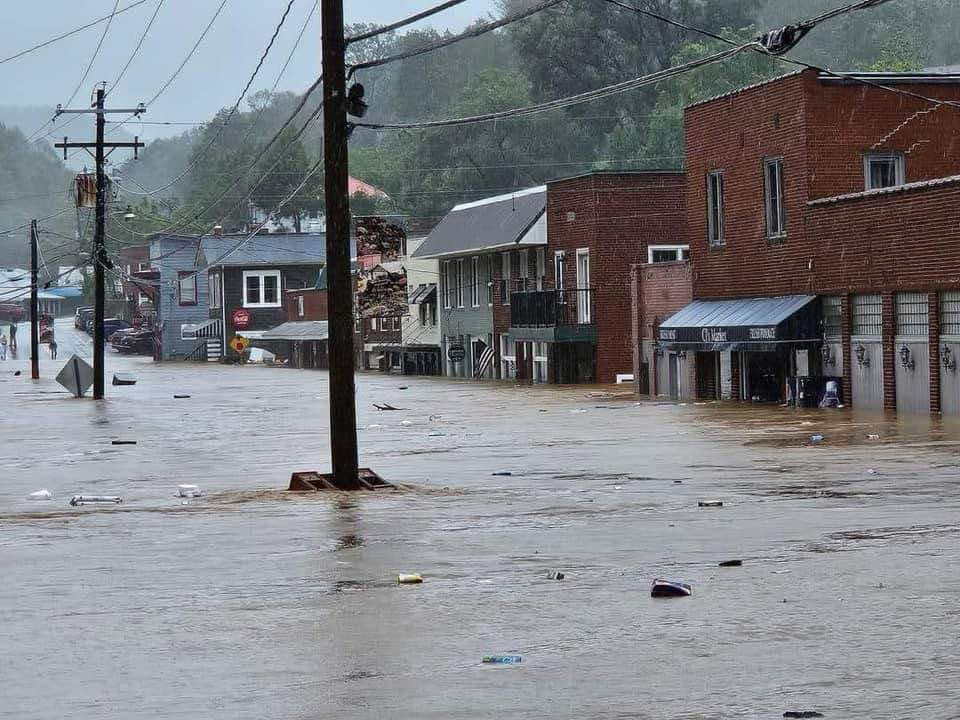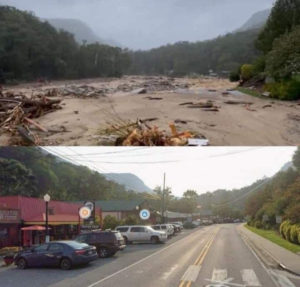Tropical Storm Helene Floods Western North Carolina

In what is being called the “Katrina of the Appalachian Mountains,” Tropical Storm Helene dropped more than 20 inches of rain in western North Carolina Friday morning, flooding countless communities and knocking out power regionwide. Helene claimed the lives of at least 30 people in Asheville, and hundreds more remain missing. Although the breadth of damage won’t be known for days, as recovery teams chainsaw and slash their way into stranded communities, meteorologists continuously compare the carnage to the region’s worst natural disasters. National Park officials recorded nearly 30 inches of rain at Mt. Mitchell – the tallest peak east of the Mississippi River – and a deluge or water, mud, and strewn debris obliterated the Village of Chimney Rock. All major thoroughfares are partially flooded, and cell phone and electric services will remain offline for weeks to come.
N.C. Governor Roy Cooper Dispatches National Guard

An endless procession of electric trucks and heavy machinery are streaming up the mountain to relieve beleaguered residents cut-off from the outside world. Helicopters rescued residents from the mountain peak towns of Banner Elk, Beech, and Sugar Mountains in northwest N.C. Saturday as a herculean airlift is now underway at any available airport to bring necessary food, medical, and water supplies. While better known for its picturesque, tranquil scenery and whimsical snowfalls, Helene proved western North Carolina is particularly susceptible to flooding and destructive sheering winds. Steep topography and gravity-fed torrents of rain can quickly overwhelm streams and adjacent communities in a matter of minutes. With nowhere to go, debris-strewn deluges can produce catastrophic flooding during heavy rain as demolished low-water bridges can strand mountain communities for weeks at a time.
‘Help is On The Way’

Tropical Storm Helene demolished the Village of Chimney Rock in North Carolina.
Although Tropical Storm Helene was devastatingly destructive by any seismic measure, an already dire situation became critical as thousands of residents remain accounted for in isolated communities cut off from neighboring towns. Families of missing residents issued urgent pleas on local Facebook pages for any information concerning their whereabouts. With most cell phone towers likely to remain offline for weeks, panic and potentially grief-stricken families can only wait for confirmation that their loved ones survived the storm. The American Red Cross and the National Guard were dispatched to the area over the weekend and makeshift emergency shelters have been sprouted up in nearly every community in western North Carolina following Helene’s onslaught.
Remote Safe Rooms Could Provide Refuge to Remote Communities

If there is any message of hope to glean from Helene’s tragic descent, it’s the importance of preparedness in protecting large populations of storm vulnerable communities. Nearly every high school gym across the Southern Appalachians is now doubling as an emergency shelter, but storm-wary residents will soon exhaust scantly available food and power supplies before again looking for shelter. Our community safe rooms can safely protect hundreds of displaced residents and can be easily and conveniently positioned away from flood-prone areas. Each customized shelter is comprised of durable and lasting solid-steel sheet paneling, protecting residents from 250-mile-per hour winds and deadly projectiles. Municipalities can offset construction costs through FEMA community block grants and financing is available for qualified applicants. Don’t let your community become another grim statistic. Invest in steel protection. Contact us today for a free quote and consultation.
